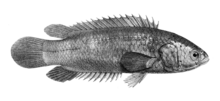
Gouramis, or gouramies, are a group of freshwater anabantiform fish that comprise the family Osphronemidae. The fish are native to Asia—from the Indian Subcontinent to Southeast Asia and northeasterly towards Korea. The name "gourami", of Indonesian origin, is also used for fish of the families Helostomatidae and Anabantidae.
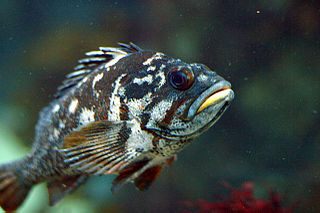
Sebastinae is a subfamily of marine fish belonging to the family Scorpaenidae in the order Scorpaeniformes. Their common names include rockfishes, rock perches, ocean perches, sea perches, thornyheads, scorpionfishes, sea ruffes and rockcods. Despite the latter name, they are not closely related to the cods in the genus Gadus, nor the rock cod, Lotella rhacina.
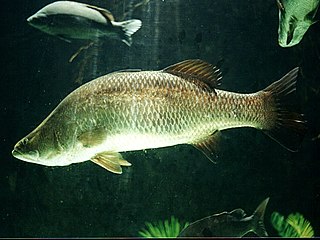
The Latidae, known as the lates perches, are a family of perch-like fish found in Africa, Asia, and the Indian and western Pacific Oceans. Including about 13 species, the family, previously classified subfamily Latinae in family Centropomidae, was raised to family status in 2004 after a cladistic analysis showed the original Centropomidae were paraphyletic.

Amphibious fish are fish that are able to leave water for extended periods of time. About 11 distantly related genera of fish are considered amphibious. This suggests that many fish genera independently evolved amphibious traits, a process known as convergent evolution. These fish use a range of terrestrial locomotory modes, such as lateral undulation, tripod-like walking, and jumping. Many of these locomotory modes incorporate multiple combinations of pectoral-, pelvic-, and tail-fin movement.

Trichogaster is a genus of gouramis native to South Asia from Pakistan to Myanmar. It is the only genus in the monotypic subfamily Trichogastrinae as set out in the 5th Edition of Fishes of the World, although that book states that there are two genera, the other being Colisa which is treated as a synonym of Trichogaster by Fishbase and the Catalog of Fishes. Fishbase also places the genus in the Luciocephalinae. Species of this genus are very popular in the aquarium trade.
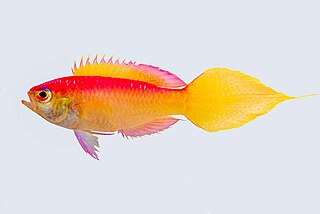
The splendid perches are a small family, the Callanthiidae, of marine ray-finned fishes in the order Spariformes. These fishes are mainly found in the Indo-Pacific but two species are found in the eastern Atlantic and Mediterranean.

The Anabantoidei are a suborder of anabantiform ray-finned freshwater fish distinguished by their possession of a lung-like labyrinth organ, which enables them to breathe air. The fish in the Anabantoidei suborder are known as anabantoids or labyrinth fish, or colloquially as gouramies. Some labyrinth fish are important food fish, and many others, such as the Siamese fighting fish and paradise fish, are popular as aquarium fish.
Climbing perch may refer to:

The climbing perch is a species of amphibious freshwater fish in the family Anabantidae. A labyrinth fish native to Far Eastern Asia, the fish inhabits freshwater systems from Pakistan, India, Bangladesh and Sri Lanka in the west, to Southern China in the east, and to Southeast Asia west of the Wallace Line in the south. It is likely that Anabas testudineus is a species complex, with the binomial name applied to what are actually several different species. With further study, populations of this fish may be divided up into separate species and given new names.
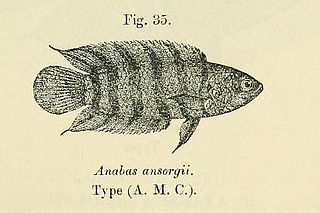
Microctenopoma ansorgii is a small freshwater fish, known in the aquarium trade as the ornate ctenopoma, orange ctenopoma, ornate climbing perch, pretty ctenopoma, or rainbow ctenopoma. It is related to the more familiar spotted climbing perch, but looks very different. Its body is more elongated and rounded, with fins with red and black stripes; the color intensifies when the fish are displaying, with black bars becoming visible on the body. The ornate ctenopoma spawns at night, laying its eggs on a floating bubble nest like its relatives in the osphronemidae. It lives in the slow-flowing forest streams of the Congo Basin, where it feeds on worms, insect larvae, and other aquatic invertebrates. It is the most common member of its genus in the aquarium trade, where it is known for being a shy, easily bullied fish that needs live or frozen foods and which benefits from the presence of smaller dither fish to encourage it to come out of hiding.

Microctenopoma is a genus of fish in the Anabantidae family. They are native to Africa. Microctenopoma has been included in Ctenopoma in the past; unlike that genus, they are bubblenest builders, and the males defend the eggs and fry until they are free swimming.

The Cape kurper is a species of fish in the family Anabantidae, the climbing gouramis or climbing perches. It is endemic to South Africa.

The leopard bush fish, also known as leopard bushfish, spotted ctenopoma, leopard ctenopoma, spotted climbing perch, spotted leaf fish, spotted cichlid or spotted bushfish, is a freshwater fish. It is a member of the family Anabantidae, which is part of a group popularly known as labyrinth fish.

The shortnose gar is a primitive freshwater fish of the family Lepisosteidae. It is native to the United States where its range includes the Mississippi and Missouri River basins, ranging from Montana to the west and the Ohio River to the east, southwards to the Gulf Coast. It inhabits calm waters in large rivers and their backwaters, as well as oxbow lakes and large pools. It is a long, slender fish, brown or olive green above and whitish below. It typically grows to about 60 cm (24 in) and is armored by rows of interlocking, rhomboidal ganoid scales.

Phallostethidae, also known as the priapium fish, is a family of atheriniform fish native to freshwater and brackish habitats in southeast Asia.

Anabas is a genus of climbing gouramies native to southern and eastern Asia. In the wild, Anabas species grow up to 30 cm (1 ft) long. They inhabit both brackish and fresh water. Anabas species possess a labyrinth organ, a structure in the fish's head which allows it to breathe atmospheric oxygen, so it can be out of water for an extended period of time, hence its name from the Greek anabainein ‘walk up’, from ana- ‘up’ + bainein ‘go’. They are carnivorous, living on a diet of water invertebrates and their larvae, and - in contrast to most of their relatives - are scatter spawners with no parental care. Species are found in South Asia, including India, Sri Lanka, Bangladesh, Burma, Indonesia, Malaysia, Thailand, Cambodia, and the Philippines.
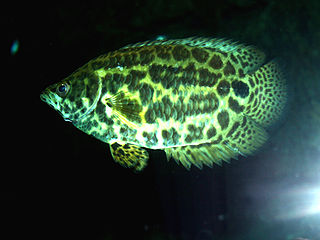
Ctenopoma is a genus of climbing gouramies native to Africa. Microctenopoma has been included in Ctenopoma in the past; in contrast to that genus, Ctenopoma species are egg scatterers with no parental care.

The Macropodusinae are a subfamily of freshwater anabantiform fishes in the gourami family Osphronemidae, which includes the paradisefish, fighting fish and licorice gouramis. Like all members of the family, these are air breathing fishes that frequently inhabit oxygen poor environments hostile to other fishes. They are native to Asia, from Pakistan and India to the Malay Archipelago and north-easterly towards Korea. Many members are common aquarium fish; by far the most famous is the Siamese fighting fish, Betta splendens. Most of the 70+ betta species are paternal mouthbrooders; the remaining members of the subfamily are bubblenesters like most osphronemids.

The Anabantiformes, collectively known as Labyrinth fish. are an order of air-breathing freshwater ray-finned fish with two suborders, five families and having at least 207 species. In addition, some authorities expand the order to include the suborder Nandoidei, which includes three families - the Nandidae, Badidae and Pristolepididae - that appear to be closely related to the Anabantiformes. The order, and these three related families, are part of a monophyletic clade which is a sister clade to the Ovalentaria, the other orders in the clade being Synbranchiformes, Carangiformes, Istiophoriformes and Pleuronectiformes. This clade is sometimes referred to as the Carangaria but is left unnamed and unranked in Fishes of the World. This group of fish are found in Asia and Africa, with some species introduced in United States of America.
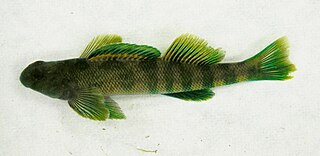
Etheosomatinae is a species-rich subfamily of freshwater ray-finned fish, the members of which are commonly known as the darters. The subfamily is part of the family Percidae which also includes the perches, ruffes and pikeperches. The family is endemic to North America. It consists of three to five different genera and well over 200 species.
